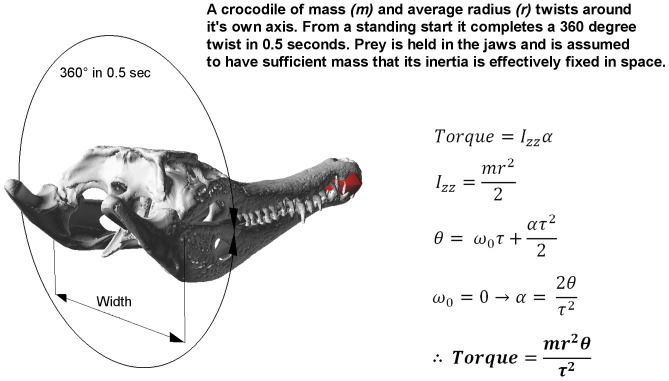Figure 15. Calculation of twist forces.
The problem definition used to determine the equations of motion that describe the feeding behaviour associated with twisting a prey item. Bottom Left: the range of motion for a crocodile twisting a prey item. Bottom right: the equations used to calculate the Torque generated by a crocodile of mass ( ) as a result of twisting about its own axis with a prey item held in its jaws. Torque is the produce of moment of inertia (
) as a result of twisting about its own axis with a prey item held in its jaws. Torque is the produce of moment of inertia ( ) about the animals long axis and the angular acceleration (
) about the animals long axis and the angular acceleration ( ) – which is assumed to be constant. Moment of inertial is calculated using mass (
) – which is assumed to be constant. Moment of inertial is calculated using mass ( ) and radius (
) and radius ( ); in our calculations mass is approximated as fifty times the mass of the skull (approx. 40 kg in the M. cataphractus example shown here), while radius is approximated as skull width (approx. 152 mm in M. cataphractus). Initial angular velocity (
); in our calculations mass is approximated as fifty times the mass of the skull (approx. 40 kg in the M. cataphractus example shown here), while radius is approximated as skull width (approx. 152 mm in M. cataphractus). Initial angular velocity ( ) is zero since in this case the twist is being made from a standing start.
) is zero since in this case the twist is being made from a standing start.  denotes the angular displacement of the twist in radians (
denotes the angular displacement of the twist in radians ( or 360 degrees in this case), while
or 360 degrees in this case), while  denotes the time taken to complete the rotation –0.5 seconds.
denotes the time taken to complete the rotation –0.5 seconds.

